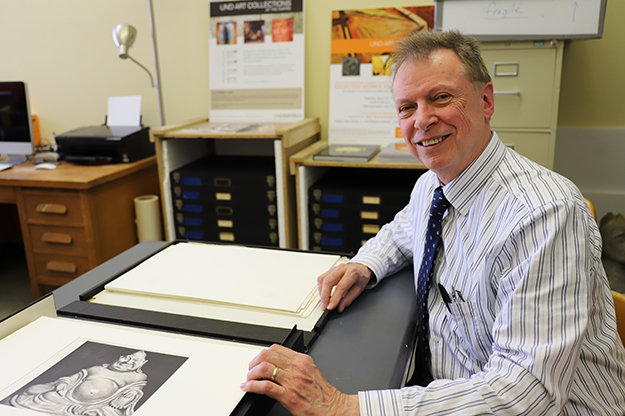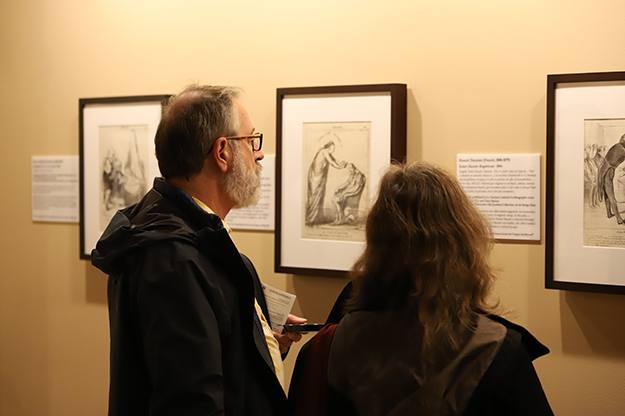Daumier on display
UND Art Collections at the Empire Arts Center features more selections from famed satirist through June 23

Since becoming the founding director of UND Art Collections in 2005, Art Jones has managed to acquire works from names like Rembrandt, Picasso and Whistler while crafting a “living museum” of UND’s campus buildings.
More recently, he established a connection that brought 1,400 original prints from famed French satirist and printmaker Honoré Daumier into the University’s possession.
March 27, Jones opened a new exhibit at the Empire Arts Center in downtown Grand Forks, where the great works of Daumier are on full display. The exhibit, Honoré Daumier III: Law, Medicine, and Social Satire, runs through June 23.
The gallery is open during Empire Arts Center events, as well as Tuesdays from 12-4 p.m.
“This is the third exhibition we’ve had at the Empire Arts Center featuring the work of Daumier,” Jones told opening reception attendees. “Law and medicine are two topics he liked to deal with, and he was much more critical of lawyers than doctors. Just to clarify, these do not reflect my personal views of the professions.”
World-class collection
Jones’s and the University’s connection to Daumier goes back to 2013, when Jones received an offer that seemed too good to turn down. A New York art dealer had around 200 prints that Jones says were available at a bargain price.
“It’s almost a fluke that we have them,” he said. “I was able to get other faculty members around campus interested in researching Daumier, so the two previous shows were results of scholarly, interdisciplinary collaborations by several professors.”
A few years later, Jones was notified of a Daumier collection in Beverly Hills, Calif., that donors were looking to give away. He knew it was a long shot, given the amount of institutions and museums potentially interested, but he reached out with a quick paragraph.
“It’s a world-class collection,” Jones said of the 1,400-piece assortment. “The pitch I gave for the University was that we didn’t have much in the way of cultural resources of this type here, and we already had an established history of studying Daumier’s work.”
Within one day, the donors responded to his pitch. Jones received a call from Denise Wior, one of the granddaughters of Lilly Jacobson (for whom the collection is named). Over the following months, they built a working relationship over the phone — allowing Jones to generate interest in the institution.
Wior and her sister, Caryn Speizer, eventually seemed committed to giving UND the entire collection. Throughout the process, Jones expressed the value of the collection as a cultural and educational resource to the region.

Compact cache
“When I first mentioned the possibility of this collection, (UND Arts & Sciences) Dean Debbie Storrs’ first response was, ‘Where are you going to put it?’” Jones said.
The dean had a good point. Finding a place for 1,400 pieces of original art sounded daunting. Would it take a room? A warehouse?
By the time Jones got to Los Angeles to meet with Wior, all he needed was an SUV.
“It all compacts into these archival boxes,” Jones gestured to two stacks of black, briefcase-looking containers in his office. “There’s 20 in total. You see the shipping boxes? Those were able to fit in the SUV, too.”
Jones drove across the country in two days with every print of the collection in tow. The gift was formally received by the University in April 2017 and recognized as the Lilly Jacobson Collection.
The collection has been fully documented and is available to view online through the UND Scholarly Commons site (under UND Art Collections).

Hints of satire, bits of humor
For Daumier III, Jones found it to be an opportunity to connect two prominent UND colleges — the School of Law and School of Medicine and Health Sciences — with the nineteenth century artist. More simply, it’s also an interesting show to provide for the curious public.

“In this region, we don’t have too many opportunities to see historical artworks of this caliber,” Jones said of the exhibit. “They’re high quality and to see anything of this type, you’d potentially have to travel a long way.
“But what’s unique is that it is historical, yet it addresses themes that might remind you of your own time. It gives you a chance to have a different type of artistic experience and to think about art in ways you might not normally.”
The inspiration behind Jones’s statement is the fact that Daumier was a paycheck-earning printmaker, producing political and satirical cartoons for magazines. Daumier produced over 4,000 lithographic sketches during his career, many of which fall in the purview of social satire.
“I’ve had the opportunity to go to art museums around the world and I regularly see Daumier exhibits in some of the finest universities,” UND President Mark Kennedy said during the exhibit’s March 27 opening. “There are many things I would love to do as a president that I have not yet found time to do; one of those would be just to take a day and page through all 1,600 prints.”
Kennedy went on to say each print has a hint of satire, a bit of humor and it would be interesting to compare what Daumier was saying then to how we satire figures in the present day. Jones also finds the work intriguing as a potential connection to the modern era.
“Daumier was a strong believer in representational government in a time where he lived either under an emperor or king,” Jones said. “His beliefs are beliefs that many of us hold today. He was interested in social justice, and he was a critic of things unjust he saw around him.”
But as with all works of art, people need to draw the conclusions for themselves.



